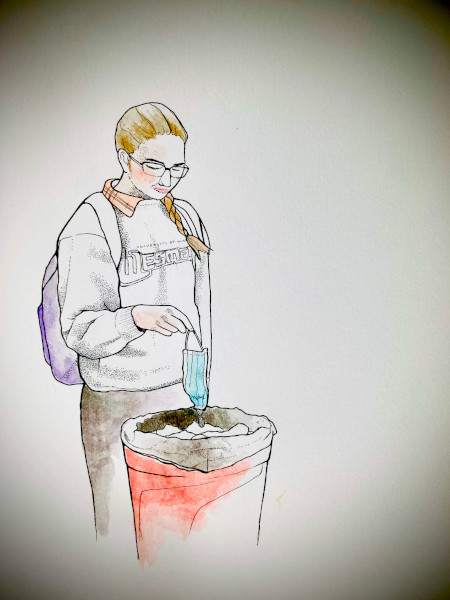To mask or not to mask
U of W removes its face-mask mandate
Illustration by Gabrielle Funk
Caleb Zimmerman, the executive director of marketing and communications at the U of W, says lifting the mask mandate was the result of serious thought and deliberation.
“Many different COVID-19 committees contributed to our ongoing response throughout the pandemic. The committees consulted within internal and external stakeholders and monitored public-health orders,” he says.
“The health and safety of our community and the commitment to provide an exceptional student experience was considered first and foremost.”
However, masks are required when indoors at the University of Manitoba. Specifically, students, staff members and visitors are instructed to wear KN95 or three-ply medical masks when in campus buildings.
This mandate doesn’t reflect the situation at most Canadian universities, Zimmerman says. According to a Canadian Press survey, only 14 out of 83 universities across the country require mask use on campus.
At Red River College, mask use is optional but supported. Staff and students are required to complete the self-screening survey provided by Shared Health prior to arriving on campus.
At Brandon University, vaccinations and masks are recommended but not required. Students and staff are asked to carry masks to wear when entering confined spaces, such as offices.
Zimmerman says that the decision to make masks optional was prompted by respect for others. “Our community was asked to respect an individual’s choice regarding masking.”
Scott Forbes, president of the Manitoba Organization of Faculty Associations and a U of W biology professor, emphasizes the critical nature of the COVID-19 pathogen. He stresses that the lasting side effects of COVID-19 remain unknown, but evidence shows that there are serious longterm consequences.
“Neurological damage is associated with COVID-19 infection, (as well as) cardiovascular damage,” he says. “We know that, somewhere, one in five and one in 12 people are likely to develop long COVID.”
While attitudes toward the virus may have softened over time, COVID-19 still poses a serious risk, especially to people who are immunocompromised.
“It’s not a cold or flu virus. It’s much more serious than that,” Forbes says.
COVID-19 is considered a level-three pathogen, which, according to lab-safety standards, means people coming into contact with the virus should use a respirator and protective garments. Essentially, “we are ignoring a level-three pathogen in our midst,” Forbes says.
For Forbes, the choice is simple. “Wearing masks is a simple and mildly inconvenient preventative measure,” he says.
When asked to comment on the campus’ mask policy, University of Winnipeg Students’ Association president Kirt Hayer aligned the UWSA with current government directives.
“The UWSA will always support public-health guidelines that ensure the safety of students, especially those with specific challenges that compromise their health,” he says.
Published in Volume 77, Number 03 of The Uniter (September 22, 2022)






